Toward Green Farming Technologies: A Case Study of Oyster Shell Application in Fruit and Vegetable Production in Xiamen
Abstract
:1. Introduction
2. Materials and Methods
2.1. Materials
2.2. Test Design
2.2.1. Shixia Longan Experimental Field
2.2.2. Chive Experimental Field
2.3. Test Method
2.3.1. Collection of Soil Samples
Collection of Soil Samples of Shixia Longan
Collection of Soil Samples of Chives
2.3.2. Determination of Soil Physical and Chemical Indexes
2.3.3. Collection of Fruit and Vegetable Samples
Collection of Shixia Longan Samples
Collection of Chive Samples
Determination of Quality Indexes of Fruits and Vegetables
2.4. Statistical Analyses
3. Results and Discussion
3.1. Effect of Oyster Shell Soil Conditioner on Soil pH Value of Shixia Longan
3.2. Effect of Oyster Shell Soil Conditioner on Soil Organic Matter of Shixia Longan
3.3. Effect of Oyster Shell Soil Conditioner on Soil Alkali Hydrolyzed Nitrogen Content of Shixia Longan
3.4. Effect of Oyster Shell Soil Conditioner on Soil Exchangeable Calcium Content of Shixia Longan
3.5. Effect of Oyster Shell Soil Conditioner on Single Fruit Weight and Appearance Quality of Shixia Longan
3.6. Effect of Oyster Shell Soil Conditioner on Solid Acid Ratio and Sugar Acid Ratio of Shixia Longan
3.7. Effect of Oyster Shell Soil Conditioner on Ascorbic Acid of Shixia Longan
3.8. Effect of Oyster Shell Soil Conditioner on Soil pH Value of Chive
3.9. Effect of Oyster Shell Soil Conditioner on Soil Organic Matter and Alkali Hydrolyzed Nitrogen of Chives
3.10. Effect of Oyster Shell Soil Conditioner on Soil Exchangeable Calcium in Chives
3.11. Effect of Oyster Shell Soil Conditioner on the Yield and Single Plant Weight of Chive
3.12. Effect of Oyster Shell Soil Conditioner on the Morphological Indexes of Chive
4. Conclusions
Author Contributions
Funding
Institutional Review Board Statement
Informed Consent Statement
Data Availability Statement
Conflicts of Interest
References
- Wall, D.H.; Nielsen, U.N.; Six, J. Soil biodiversity and human health. Nature 2015, 528, 69–76. [Google Scholar] [CrossRef] [PubMed]
- Endale, T.; Diels, J.; Tsegaye, D. Farmer-science-based soil degradation metrics guide prioritization of catchment-tailored control measures. Environ. Dev. 2023, 45, 100783. [Google Scholar] [CrossRef]
- Lin, S.; Wang, W.; Vancov, T. Soil carbon, nutrients and their stoichiometry decrement in relation to paddy field degradation: Investigation in a subtropical region. Catena 2022, 217, 106484. [Google Scholar] [CrossRef]
- Jin, Q.; Wang, C.; Sardans, J. Effect of soil degradation on the carbon concentration and retention of nitrogen and phosphorus across Chinese rice paddy fields. Catena 2022, 209, 105810. [Google Scholar] [CrossRef]
- Liang, X.; Xin, Z.; Shen, H. Deep soil water deficit causes Populus simonii Carr degradation in the three north shelterbelt region of China. J. Hydrol. 2022, 612, 128201. [Google Scholar] [CrossRef]
- Bolan, N.; Sarmah, A.-K.; Bordoloi, S. Soil acidification and the liming potential of biochar. Environ. Pollut. 2023, 317, 120632. [Google Scholar] [CrossRef]
- Fujii, K.; Funakawa, S.; Kosaki, T. Effects of forest management on soil acidification in cedar plantation. Geoderma 2022, 424, 115967. [Google Scholar] [CrossRef]
- Qi, S.; Li, X.; Luo, J. Soil heterogeneity influence on the distribution of heavy metals in soil during acid rain infiltration: Experimental and numerical modeling. J. Environ. Manag. 2022, 322, 116144. [Google Scholar] [CrossRef]
- Wei, H.; Liu, Y.; Zhang, J. Leaching of simulated acid rain deteriorates soil physiochemical and mechanical properties in three agricultural soils. Catena 2021, 206, 105485. [Google Scholar] [CrossRef]
- Zhang, Y.; Ye, C.; Su, Y. Soil acidification caused by excessive application of nitrogen fertilizer aggravates soil-borne diseases: Evidence from literature review and field trials. Agric. Ecosyst. Environ. 2022, 340, 108176. [Google Scholar] [CrossRef]
- Li, A.; Li, C.; Zhang, Y. The driving factors and buffering mechanism regulating cropland soil acidification across the Sichuan basin of China. Catena 2023, 220, 106688. [Google Scholar] [CrossRef]
- Becerra-Agudelo, E.; López, J.-E.; Betancur-García, H. Assessment of the application of two amendments (lime and biochar) on the acidification and bioavailability of Ni in a Ni-contaminated agricultural soils of northern Colombia. Heliyon 2022, 8, e10221. [Google Scholar] [CrossRef] [PubMed]
- Yin, S.; Zhang, X.; Suo, F. Effect of biochar and hydrochar from cow manure and reed straw on lettuce growth in an acidified soil. Chemosphere 2022, 298, 134191. [Google Scholar] [CrossRef]
- Cai, Z.; Wang, B.; Zhang, L. Striking a balance between n sources: Mitigating soil acidification and accumulation of phosphorous and heavy metals from manure. Sci. Total Environ. 2021, 754, 142189. [Google Scholar] [CrossRef] [PubMed]
- Liu, Q.; Liao, Y.; Zhu, J. Influence of biodeposition by suspended cultured oyster on the distributions of trace elements in multiple media in a semi-enclosed bay of China. J. Hazard. Mater. 2023, 443, 130347. [Google Scholar] [CrossRef] [PubMed]
- Huang, Y.; Li, Z.; Sun, C. Using the roughness height and manning number in hydrodynamic model to estimate the impact of intensive oyster aquaculture by floating & fixed rafts on water exchange with an application in Qinzhou bay, China. Ecol. Model. 2023, 476, 110230. [Google Scholar]
- China Agriculture Press. China Fishery Ststistical Yearbook; China Agriculture Press: Beijing, China, 2022. [Google Scholar]
- Jeong, I.; Kim, K. Utilizing a granulated coal bottom ash and oyster shells for nutrient removal in eutrophic sediments. Mar. Pollut. Bull. 2022, 177, 113549. [Google Scholar] [CrossRef] [PubMed]
- Wu, S.; Liang, L.; Zhang, Q. The ion-imprinted oyster shell material for targeted removal of Cd(II) from aqueous solution. J. Environ. Manag. 2022, 302, 114031. [Google Scholar] [CrossRef]
- Sun, Q.; Zhao, C.; Qiu, Q. Oyster shell waste as potential co-substrate for enhancing methanogenesis of starch wastewater at low inoculation ratio. Bioresour. Technol. 2022, 361, 127689. [Google Scholar] [CrossRef]
- Shi, Z.; Zhang, L.; Yuan, H. Oyster shells improve anaerobic dark fermentation performances of food waste: Hydrogen production, acidification performances, and microbial community characteristics. Bioresour. Technol. 2021, 335, 125268. [Google Scholar] [CrossRef]
- Liu, J.; Lin, Y.; Lin, H. Impacts of exogenous ROS scavenger ascorbic acid on the storability and quality attributes of fresh longan fruit. Food Chem. X. 2021, 12, 100167. [Google Scholar] [CrossRef]
- Li, Y.Q.; Zhang, Q.; Huang, Y.S. Improvement effect on acidic soil and the quality of guanxi pomelo by calcined oyster shell powder. J. Jimei Univ. (Nat. Sci.) 2020, 25, 256–264. [Google Scholar]
- Xu, L.L.; Weng, L.; Zhang, Q. Effect of oyster shell soil conditioner on the production and quality of ‘chuntao’ tomato. J. Jimei Univ. (Nat. Sci.) 2022, 27, 37–44. [Google Scholar]
- Ding, X.Y.; Wang, Y.; Weng, L. Effect of calcined oyster shell powder on acidified plantation soil and fruit quality of litchi. J. Jimei Univ. (Nat. Sci.) 2022, 27, 408–416. [Google Scholar]
- Huang, D.; Luo, T. Tebei calcium oyster powder may enhance rice output, decrease rice heavy metal concentration and reduce soil acidity. J. Phys. Conf. Ser. 2021, 1732, 12104–12106. [Google Scholar] [CrossRef]
- Kooch, Y.; Amani, M.; Abedi, M. The effect of shrublands degradation intensity on soil organic matter-associated properties in a semi-arid ecosystem. Sci. Total Environ. 2022, 853, 158664. [Google Scholar] [CrossRef]
- Li, H.; Liu, G.; Luo, H. Labile carbon input and temperature effects on soil organic matter turnover in subtropical forests. Ecol. Indic. 2022, 145, 109726. [Google Scholar] [CrossRef]
- Liu, S.; Wang, M.; Yin, M. Fifteen years of crop rotation combined with straw management alters the nitrogen supply capacity of upland-paddy soil. Soil Tillage Res. 2022, 215, 105219. [Google Scholar] [CrossRef]
- Ma, T.; Hui, Y.; Zhang, L. Foliar application of chelated sugar alcohol calcium fertilizer for regulating the growth and quality of wine grapes. Int. J. Agric. Biol. Eng. 2022, 15, 153–158. [Google Scholar] [CrossRef]
- Milošević, T.; Milošević, N.; Mladenović, J. The influence of organic, organo-mineral and mineral fertilizers on tree growth, yielding, fruit quality and leaf nutrient composition of apple cv. ‘Golden Delicious Reinders’. Sci. Hortic. 2022, 297, 110978. [Google Scholar] [CrossRef]
- Wang, K.; Hou, J.; Zhang, S. Preparation of a new biochar-based microbial fertilizer: Nutrient release patterns and synergistic mechanisms to improve soil fertility. Sci. Total Environ. 2022, 160478. [Google Scholar] [CrossRef] [PubMed]
- Chen, G.; Huang, Y.; Xiong, L. Effect of calcium fertilizer on the fruit yield and quality of Chuntian tangerine. J. South. Agric. 2013, 85, 87–98. [Google Scholar]
- Wheeler, G.L.; Jones, M.A.; Smirnoff, N. The biosynthetic pathway of vitamin c in higher plants. Nature 1998, 393, 365–369. [Google Scholar] [CrossRef] [PubMed]
- Chatzopoulou, F.; Sanmartin, M.; Mellidou, I. Silencing of ascorbate oxidase results in reduced growth, altered ascorbic acid levels and ripening pattern in melon fruit. Plant Physiol. Biochem. 2020, 156, 291–303. [Google Scholar] [CrossRef] [PubMed]
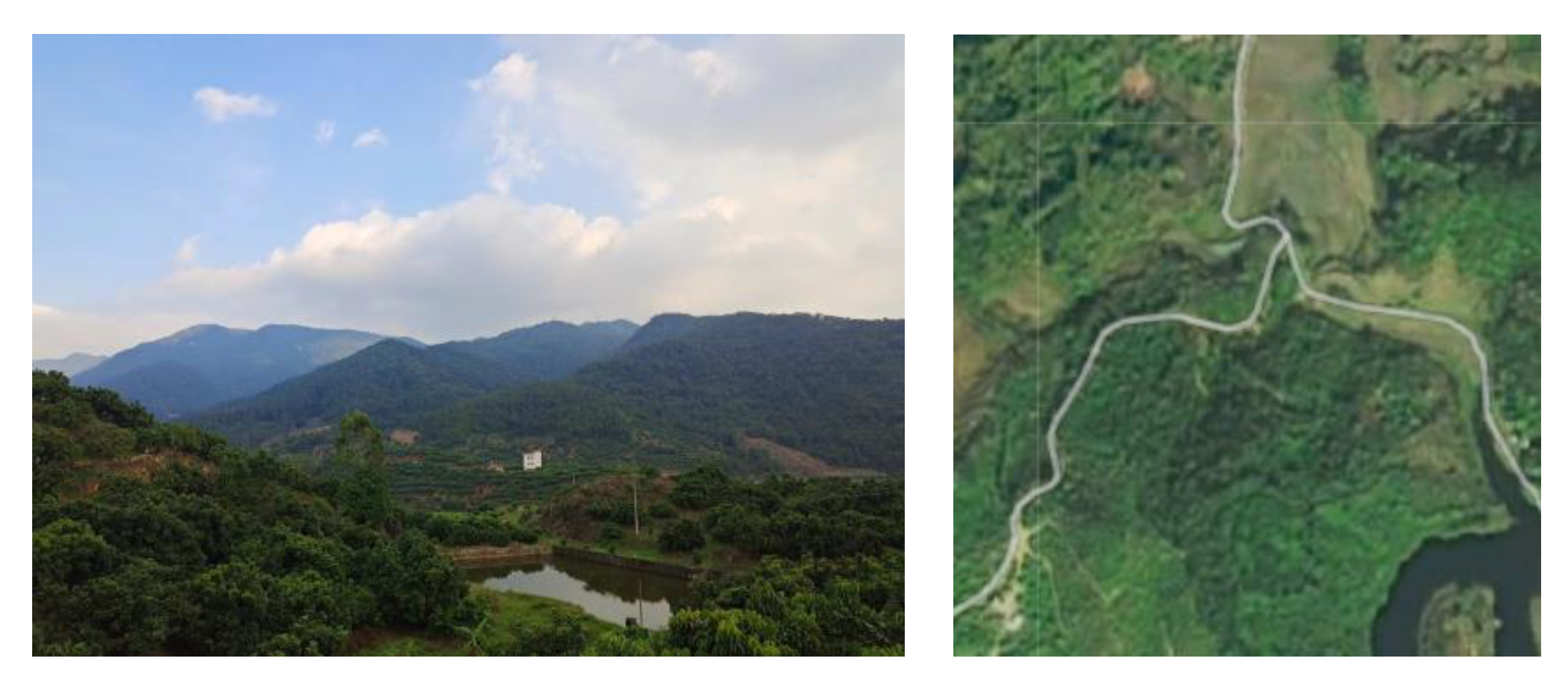
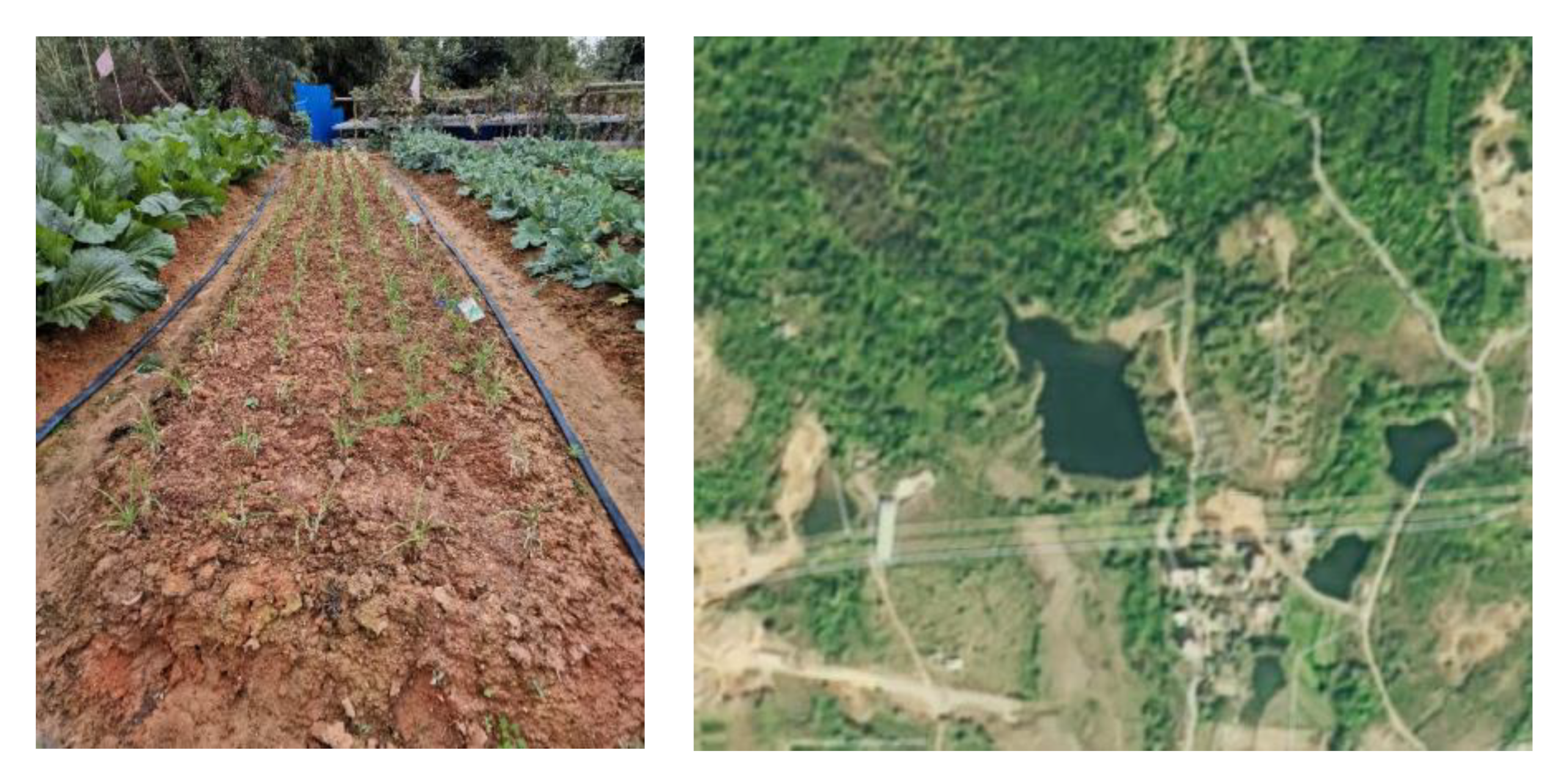
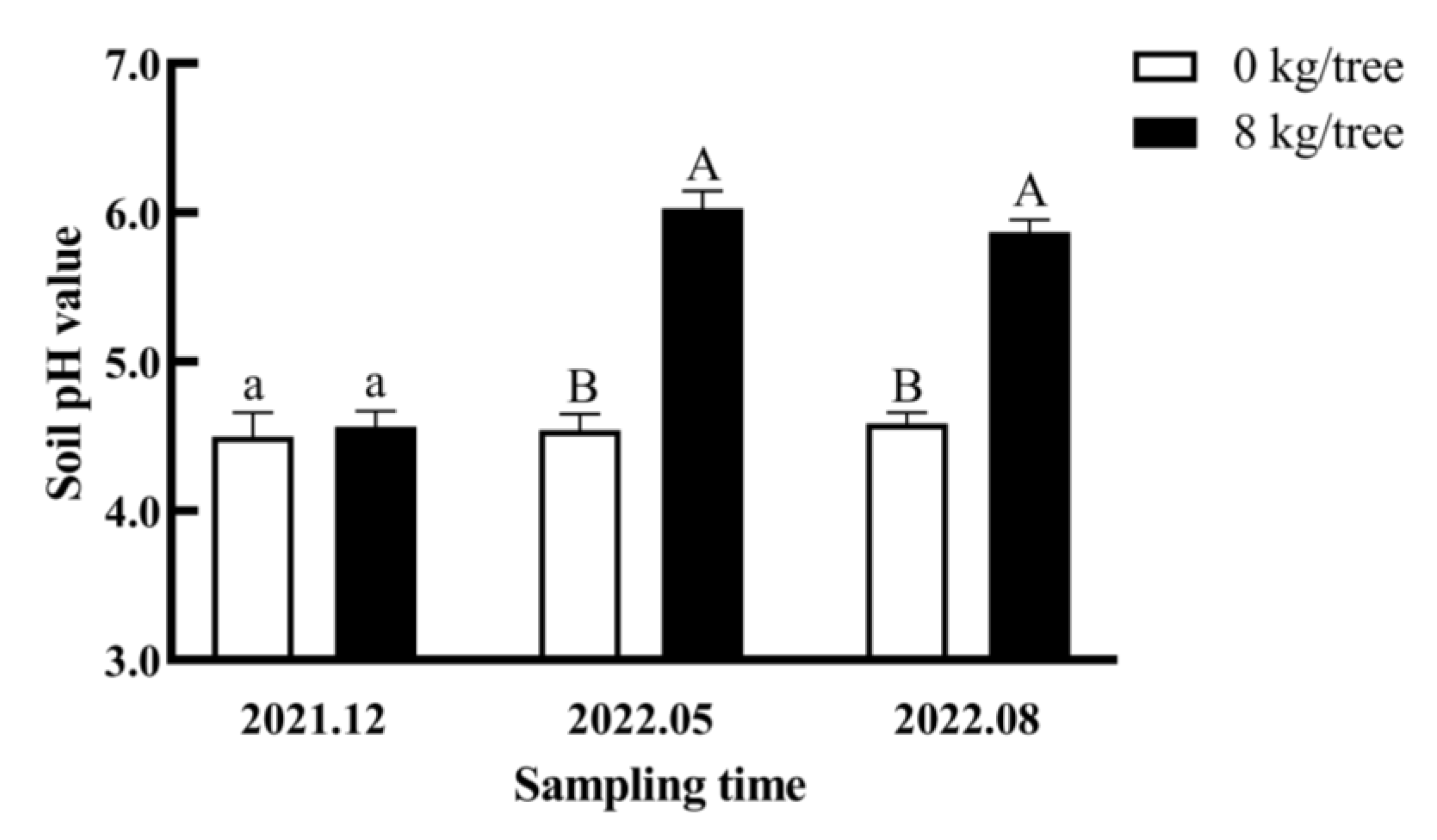


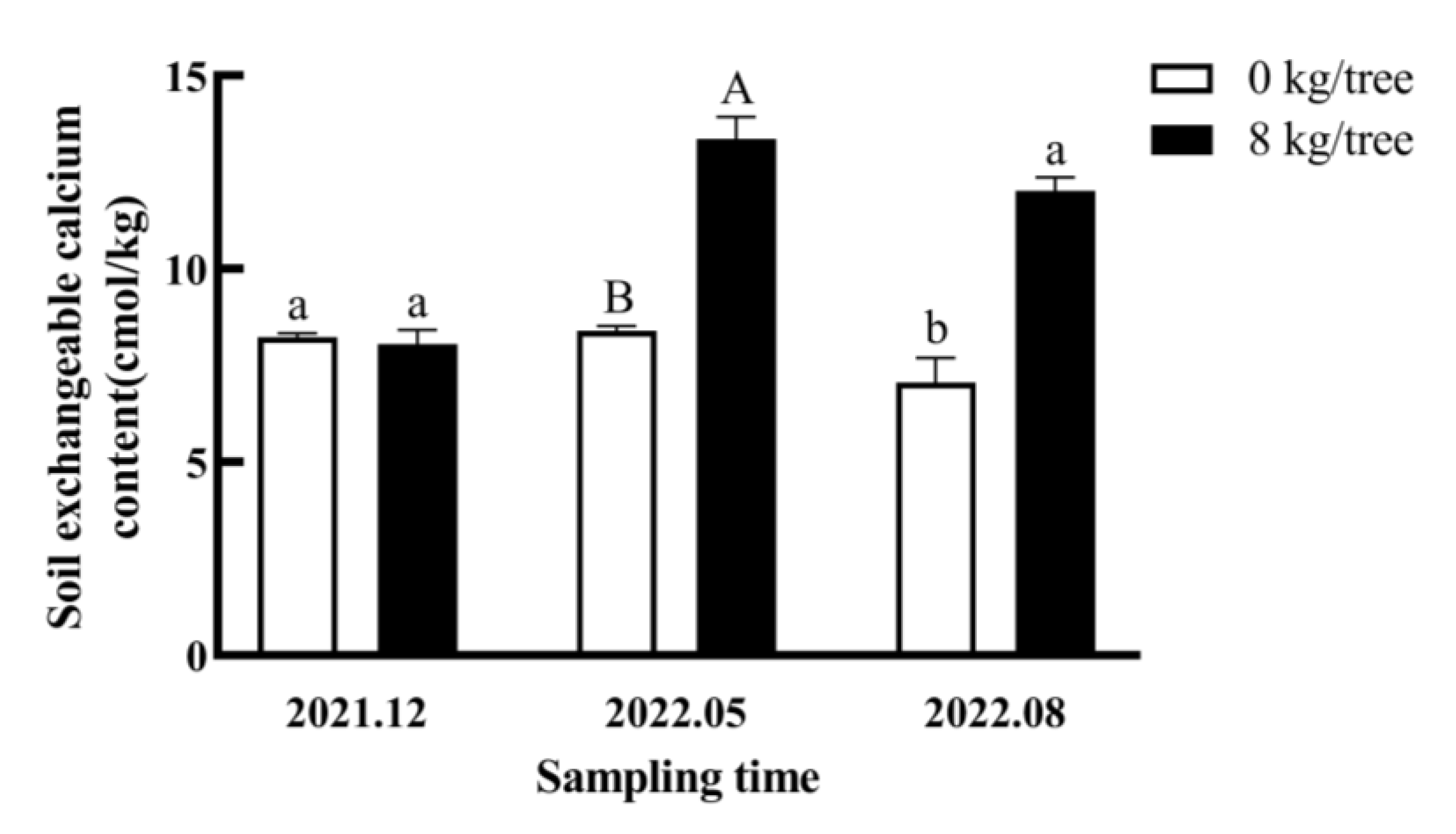
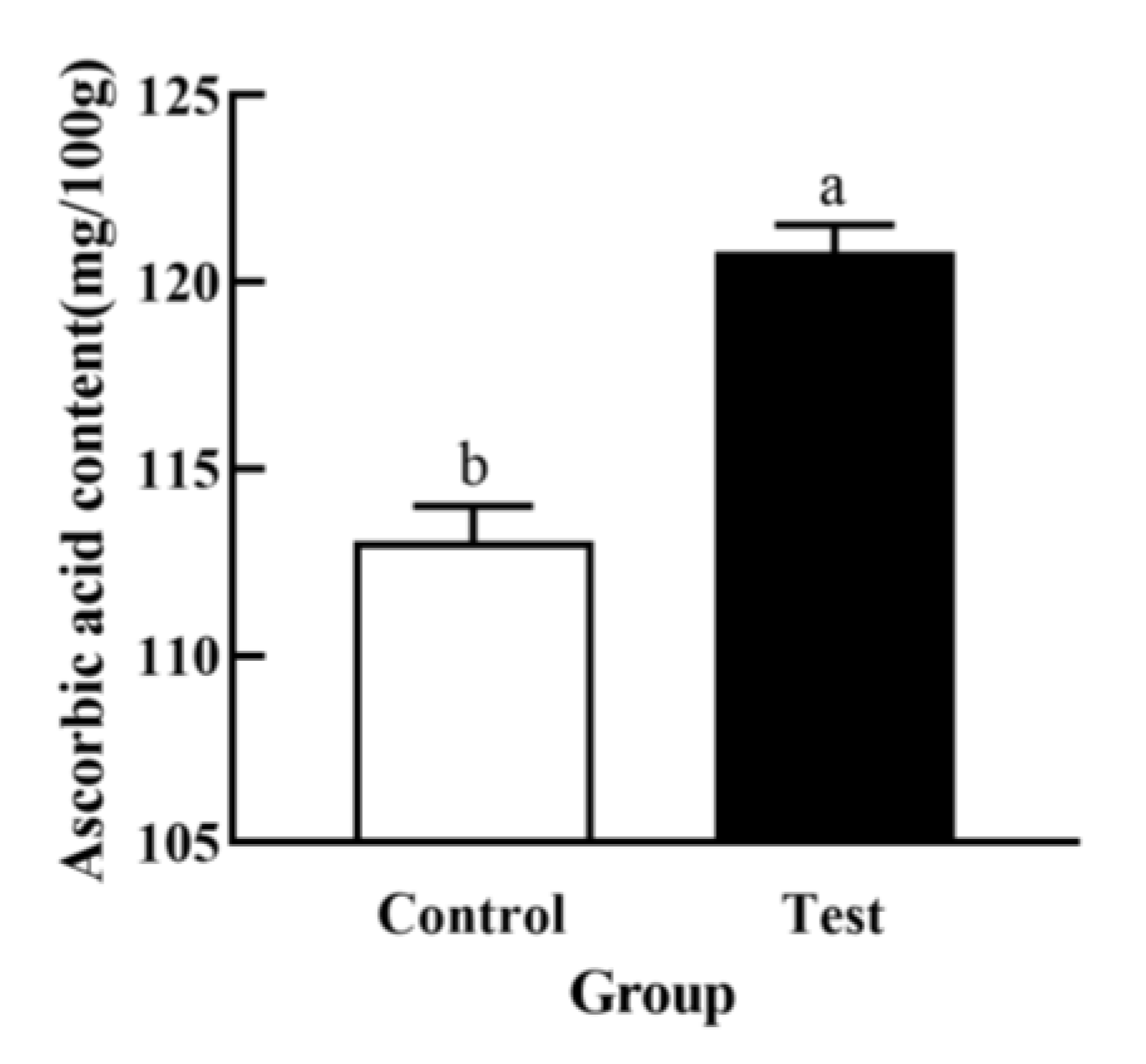

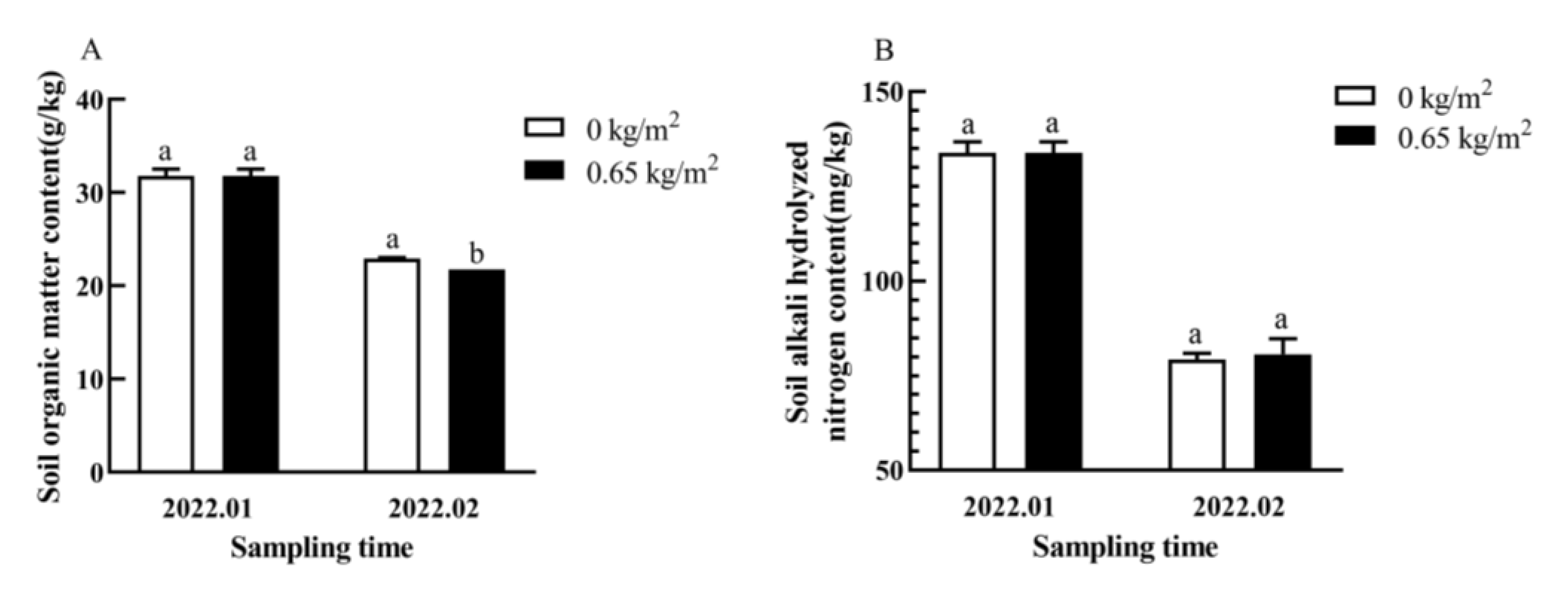
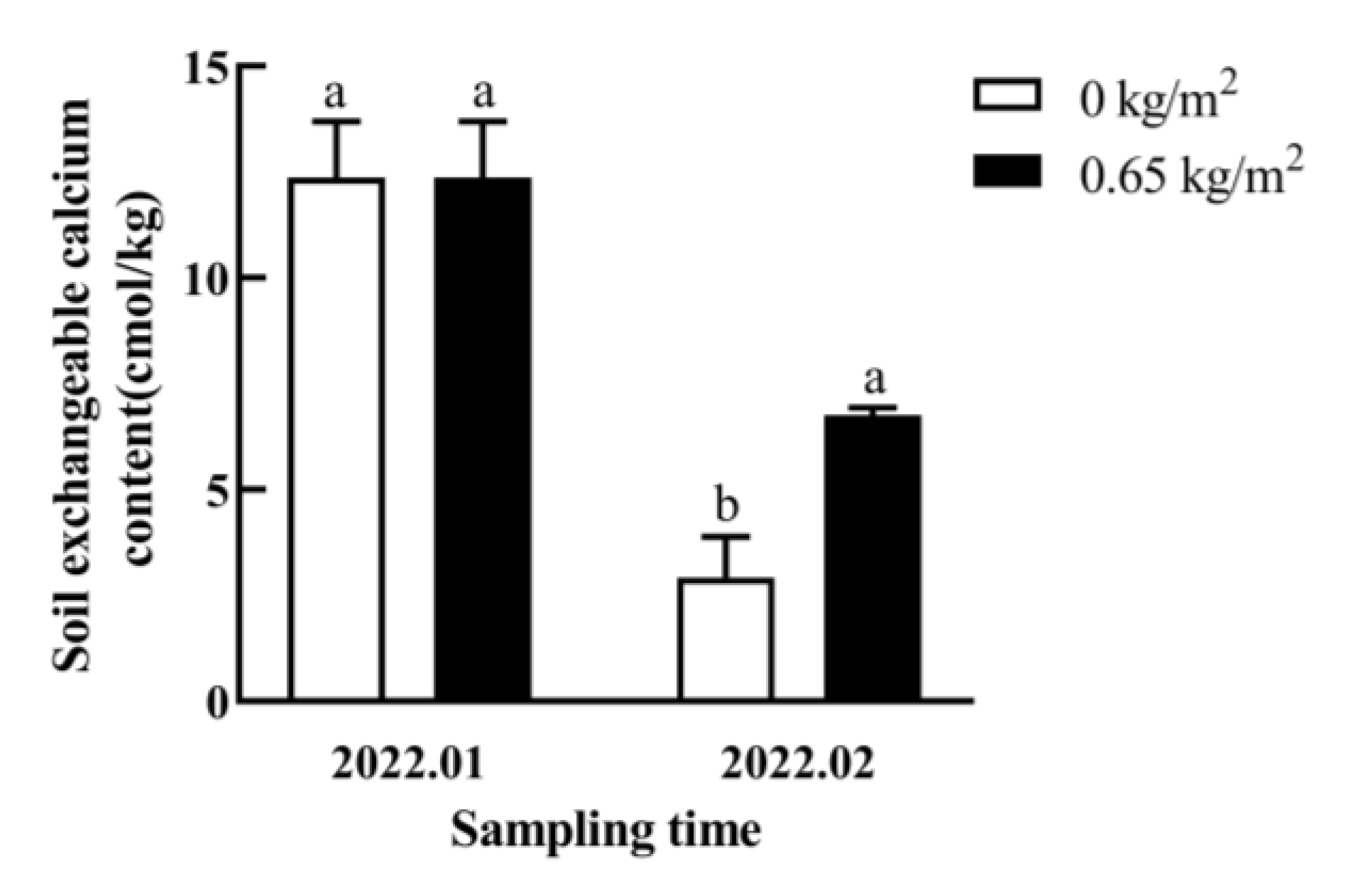
| Indicator | Content |
|---|---|
| Ca | 48% |
| Mg | 0.81% |
| Cu | 0.00049% |
| Fe | 0.14% |
| Zn | 0.0022% |
| Mo | <0.0001% |
| Se | 0.51 mg/kg |
| Group | Control | Experiment |
|---|---|---|
| Single fruit weight (g) | 7.85 ± 0.19 b | 8.35 ± 0.27 a |
| Transverse diameter (mm) | 23.63 ± 0.23 b | 24.48 ± 0.30 a |
| Longitudinal diameter (mm) | 22.94 ± 0.39 a | 23.05 ± 0.33 a |
| Pericarp thickness (mm) | 0.75 ± 0.02 b | 0.80 ± 0.01 a |
| Pulp thickness (mm) | 5.28 ± 0.11 b | 5.44 ± 0.17 a |
| Group | Control | Experiment |
|---|---|---|
| Total soluble solids (%) | 20.47 ± 0.06 b | 23.73 ± 0.06 a |
| Soluble sugar (%) | 18.05 ± 0.08 b | 20.97 ± 0.06 a |
| Titratable acid (%) | 1.37 ± 0.03 b | 1.22 ± 0.01 a |
| solid acid ratio | 14.94 | 19.45 |
| sugar acid ratio | 13.18 | 17.19 |
| Group | Control | Experiment |
|---|---|---|
| Single plant weight (g) | 127.8 ± 35.65 b | 197.98 ± 73.62 a |
| yield (kg/ha) | 18,135 | 28,620 |
| Group | Control | Experiment |
|---|---|---|
| Tiller number | 14 ± 1 | 14 ± 4 |
| Number of blades (piece) | 54 ± 7 | 61 ± 16 |
| Plant height (cm) | 62.84 ± 3.17 b | 68.04 ± 4.13 a |
| Leaf length (cm) | 48.68 ± 3.22 | 51.47 ± 3.68 |
| Pseudo stem length (cm) | 6.06 ± 0.39 a | 6.19 ± 0.38 a |
| Root length (cm) | 8.18 ± 0.77 b | 10.38 ± 2.26 a |
| Pseudostem diameter (mm) | 7.80 ± 1.79 b | 9.62 ± 0.84 a |
Disclaimer/Publisher’s Note: The statements, opinions and data contained in all publications are solely those of the individual author(s) and contributor(s) and not of MDPI and/or the editor(s). MDPI and/or the editor(s) disclaim responsibility for any injury to people or property resulting from any ideas, methods, instructions or products referred to in the content. |
© 2022 by the authors. Licensee MDPI, Basel, Switzerland. This article is an open access article distributed under the terms and conditions of the Creative Commons Attribution (CC BY) license (https://creativecommons.org/licenses/by/4.0/).
Share and Cite
Wang, Y.; Ji, M.; Wu, M.; Weng, L.; Wang, Y.; Hu, L.; Cao, M.-J. Toward Green Farming Technologies: A Case Study of Oyster Shell Application in Fruit and Vegetable Production in Xiamen. Sustainability 2023, 15, 663. https://doi.org/10.3390/su15010663
Wang Y, Ji M, Wu M, Weng L, Wang Y, Hu L, Cao M-J. Toward Green Farming Technologies: A Case Study of Oyster Shell Application in Fruit and Vegetable Production in Xiamen. Sustainability. 2023; 15(1):663. https://doi.org/10.3390/su15010663
Chicago/Turabian StyleWang, Yan, Mengya Ji, Min Wu, Ling Weng, Yongming Wang, Lingyi Hu, and Min-Jie Cao. 2023. "Toward Green Farming Technologies: A Case Study of Oyster Shell Application in Fruit and Vegetable Production in Xiamen" Sustainability 15, no. 1: 663. https://doi.org/10.3390/su15010663
APA StyleWang, Y., Ji, M., Wu, M., Weng, L., Wang, Y., Hu, L., & Cao, M.-J. (2023). Toward Green Farming Technologies: A Case Study of Oyster Shell Application in Fruit and Vegetable Production in Xiamen. Sustainability, 15(1), 663. https://doi.org/10.3390/su15010663






